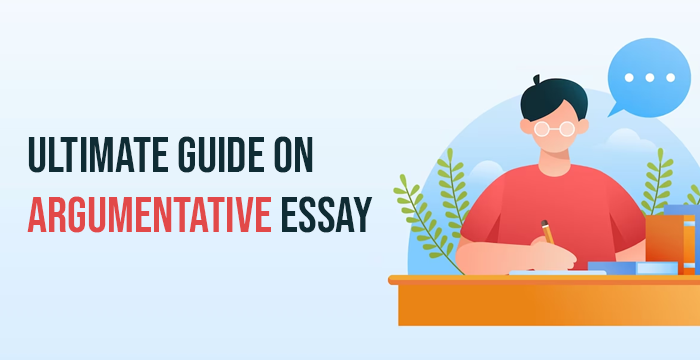
Argument as the form of presenting theory has been used since Plato, the earliest critic in history. In his work ‘Republic’ Plato has expressed his ideas through discussions among imaginary disciples of Socrates. Argument is a reliable way of producing information as it allows opposing ideas rather than emphasizing on one aspect only which might sound superfluous or suspective.
An arguing essay demonstrates conflicting concepts where a writer takes one side and proves why it is right. Writing an argumentative essay requires research, critical examination, and attention to detail, including choosing a controversial topic, making strong claims, and using impactful language. If you are feeling overwhelmed, don’t worry. The Assignment Ninjas are here for your rescue. Discover everything you need to know about argument essays in this blog. Get insights into topics, structure for argumentative essay, rules and essential guidelines which will make you sail smoothly through writing an argumentative write-up.
What is an Argument essay?
As the name suggests, an argumentative essay consists of arguments. It involves exhibiting conflicting sides of a debatable issue and justifying why one of the sides is correct. The writer takes a stance and defends it by presenting relevant facts, stats, quotes and a strong vocabulary. It is vital that the information is asserted objectively. Although you choose to support one area, your arguments should be based on facts and logic and not on personal bias. An argument essay has more convincing power because it answers the conflicting questions rather than avoiding them and then points out why a particular side is right. There are four types of arguments:
1. The Rogerian Argument:
A Rogerian argument aims to reach a conclusion by identifying a middle ground between two sides. The views, beliefs, arguments of both the sides are analyzed, the pros and cons of each are marked and then a common ground is reached by balancing both the viewpoints.
2. The Toulmin Argument:
There are six parts of a Toulmin argument viz. Claim, grounds, warrant, backing, qualifier and rebuttal. Claim is the stance of the writer, grounds are the credible evidence in support of the claim, warrant links ground and claim, backing is additional substance of support, qualifier underpins that claim is not universal and rebuttal exhibits other viewpoints for the claim.
3. Aristotelian Argument:
The purpose of Aristotelian argument is to convince the readers to accept one point of view by confirming it and refuting other theories. You state your idea, back it with proof and reject the opposing claim. It tries to change people’s beliefs and ideologies. Aristotelian argument utilises Aristotle’s principles of ethos (ethics), pathos (emotions) and logos (logic) to formulate discussions.
4. Rebuttal Argument:
Rebuttal argument questions the existing beliefs, ideas and concepts. It finds out flaws in the prevalent research and presents counterarguments. It involves criticism and debates against accepted ideas and attempts to transform previously held opinions.
Sample topics for argumentative essay:
A topic for an argumentative essay should have substantial information on both sides. You should be able to demonstrate a good deal of arguments on your side. It should be interesting for the readers and not too dry or worn out. The topic must spark the audience's curiosity, should be relevant and compelling. Here are a few examples for good topics:
- Should online education be considered valid?
- Will AI create or destroy jobs?
- Should censor board examinations be removed from adult films?
- Should religious education be promoted?
- Should India adopt an official language?
- Is atheism a progressive belief?
- Democracy vs socialism
- Success and failures of UN in solving world conflicts and problems
- Are standardized tests effective or ineffective?
- Should India adopt a Uniform Civil Code?
- Bright and dark aspect of modern day feminism
How to write an argumentative essay:
What stands out in this type of essay is its organisation. As you have many arguments and counterarguments; arranging them in a proper order will make the essay understandable without the statements going haywire. Choose from the style mentioned above and make an outline for an argumentative essay. Write in bullet points what all will go in introduction, body and conclusion. Once the roadmap is ready you will have a clear idea on how to proceed and complete the essay successfully. Let’s explore the argumentative essay format:
Introduction:
How to start an argumentative essay is the most daunting part for many students. Like informative essays, argumentative essays also begin with an introduction. The introduction consists of a hook, background and thesis statement. A hook is a captivating sentence written at the start to attract the reader towards the article. A statistic, quote or question make for good hooks in an argumentative essay. After writing the hook, give a short background of your topic to provide the base to the reader. Then present the thesis statement which will showcase your main idea in the essay. The thesis statement is an amalgamation of the summary of your essay and the point you want to argue for. In longer research papers, you can give an overview of your essay by denoting the stepwise structure your essay will navigate through.
Body:
The body comprises 3-4 (or more) paragraphs where you lay down your details, evidence, analysis, criticisms and inferences. In long scholarly works, the body is divided into sections with headings. Each paragraph should have a topic sentence which is the pivot of the paragraph. Further, provide research findings, facts and figures, information from secondary sources, quotations, etc. to prove your viewpoint. Include your own critical assessments and analysis.
Depending upon the style you opt for, the body paragraphs will be crafted. For example, if you are using Rogerian style, first put forth the argument backed with research, then present the counterargument and then conclude with a final statement reflecting on the points mentioned in the paragraph. The same is followed in rebuttal type. In Aristotelian style the pattern is reversed. The supported claim is stated first and then the opposing views are conveyed. The conflicting ideas are refuted and the supported claim is reiterated. Towards the end of the paragraph you can hint at the next paragraph’s content for an easy transition.
Conclusion:
Conclusion is a place for summarizing the article by providing a gist of significant ideas in the essay. It revises the entire article to the reader in short. Highlight the significance of your arguments and leave a trail for the reader to explore further. In scholarly pieces, the strengths and limits of the works are also included in the conclusion. Make sure to leave an impression on the reader’s mind with an impactful conclusion.
To understand better how to build arguments in a paper, it is advisable to read a few samples of essays.
Argumentative essays develop critical thinking, analytical abilities and research skills. Besides being given as an independent assignment, arguments are also made in scholarly research papers. So, it is essential to learn the intricacies of argumentative essays. Choose an intriguing and relatable topic on which you can argue with substantial facts. Select the style of arguing and devise a plan with rough points. Organise your essay appropriately to facilitate the reader to understand the arguments presented by you. Avoid using flowery language or making emotional appeals. Sound as objective as you can with powerful language. Provide plenty of evidence to back your viewpoints and increase credibility. Finally edit and proofread before you submit. If you follow the guidelines explained here we assure that your essay writing will be hassle free and results outstanding.


